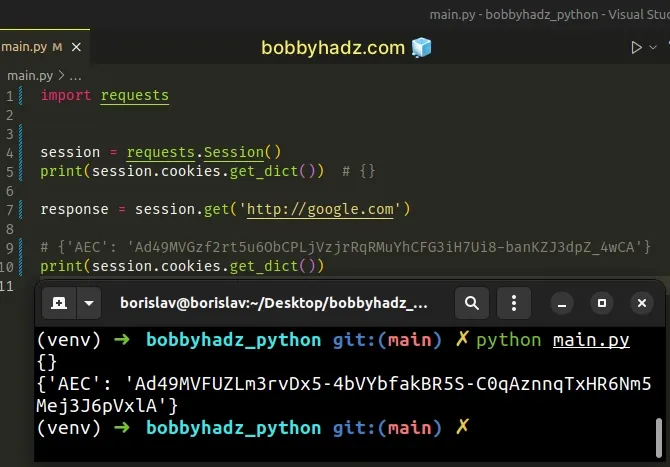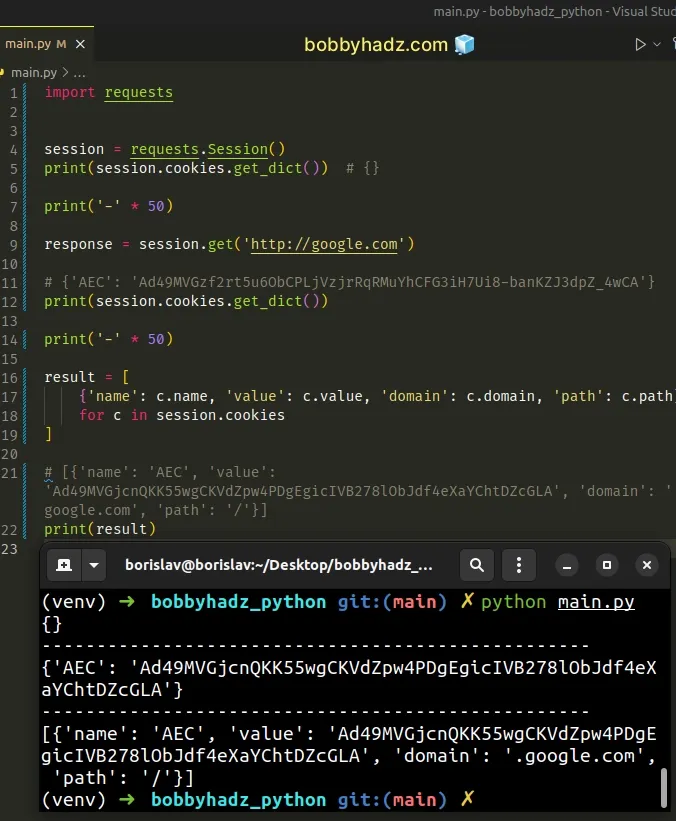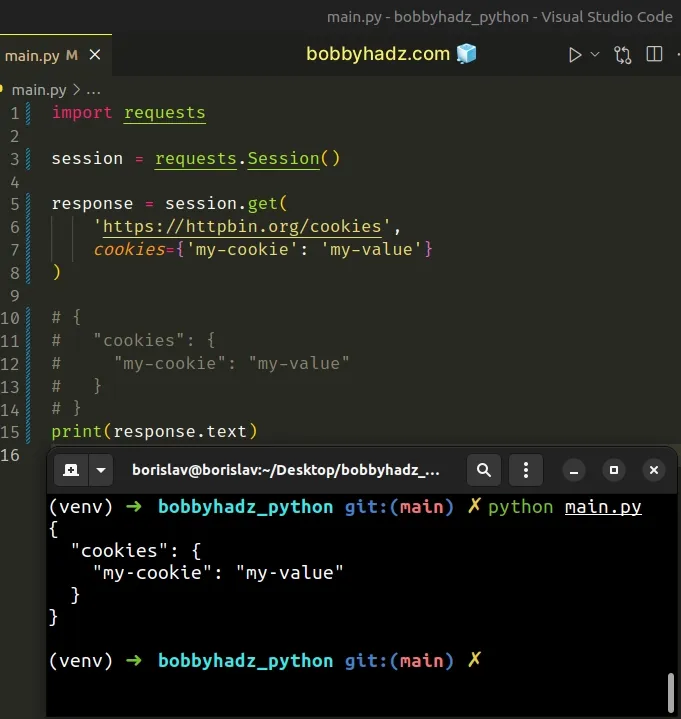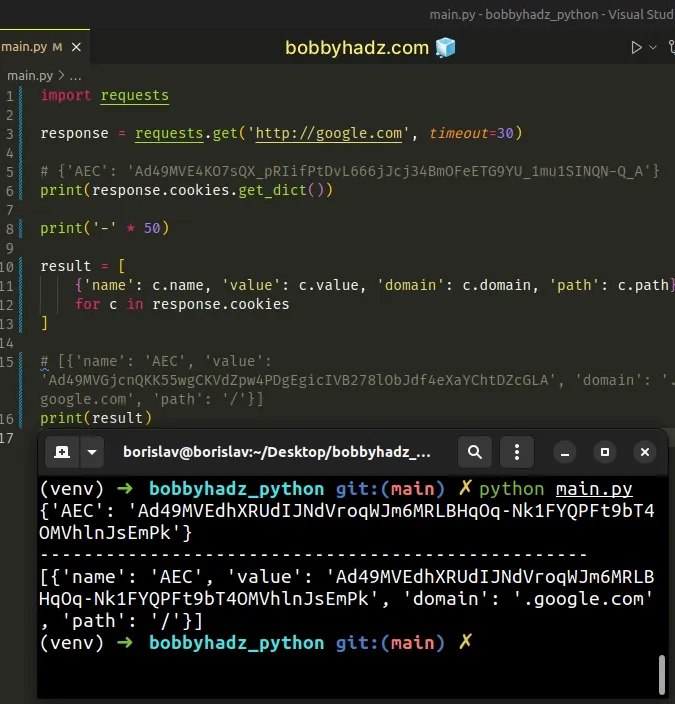Python: How to get and set Cookies when using Requests
Last updated: Apr 11, 2024
Reading time·4 min

# Table of Contents
- Python: How to get and set Cookies when using Requests
- Accessing the path and the domain when using Cookies with requests
- Sending cookies with a request
- Accessing the cookies attribute directly on the
Responseobject - Saving the
requestscookies in a file and restoring them
# Python: How to get and set Cookies when using Requests
Use the Session class to set and get cookies when using the requests
module in Python.
The class creates a Session object that stores the cookies and all requests
that are made handle cookies automatically.
import requests session = requests.Session() print(session.cookies.get_dict()) # {} response = session.get('http://google.com') # {'AEC': 'Ad49MVGzf2rt5u6ObCPLjVzjrRqRMuYhCFG3iH7Ui8-banKZJ3dpZ_4wCA'} print(session.cookies.get_dict())

Make sure you have the requests module installed to be able to run the code sample.
pip install requests # or with pip3 pip3 install requests
The Session object enables you to persist cookies across requests.
The object persists cookies across all requests that were made using the
Session instance.
The Session object has all of the methods of the main requests API.
The get_dict() method returns a Python dictionary of the name-value pairs of
cookies.
You can also use Sessions as context managers.
import requests with requests.Session() as session: print(session.cookies.get_dict()) # {} response = session.get('http://google.com') # {'AEC': 'Ad49MVGzf2rt5u6ObCPLjVzjrRqRMuYhCFG3iH7Ui8-banKZJ3dpZ_4wCA'} print(session.cookies.get_dict())
Make sure the code that accesses the Session object is inside the indented
block.
# Accessing the path and the domain when using Cookies with requests
It is very likely, that you will also have to access the domain and the path to which the request was made when accessing the cookies.
You can use a list comprehension to construct a list of dictionaries that contain the path and domain.
import requests session = requests.Session() print(session.cookies.get_dict()) # {} print('-' * 50) response = session.get('http://google.com') # {'AEC': 'Ad49MVGzf2rt5u6ObCPLjVzjrRqRMuYhCFG3iH7Ui8-banKZJ3dpZ_4wCA'} print(session.cookies.get_dict()) print('-' * 50) result = [ {'name': c.name, 'value': c.value, 'domain': c.domain, 'path': c.path} for c in session.cookies ] # [{'name': 'AEC', 'value': 'Ad49MVGjcnQKK55wgCKVdZpw4PDgEgicIVB278lObJdf4eXaYChtDZcGLA', 'domain': '.google.com', 'path': '/'}] print(result)

We used a list comprehension to iterate over the RequestCookieJar object
(session.cookies) and returned a dictionary on each iteration.
The dictionary contains the name and value of the cookie, the path and the domain.
# Sending cookies with a request
If you want to send cookies with a request, set the cookies keyword argument.
import requests session = requests.Session() response = session.get( 'https://httpbin.org/cookies', cookies={'my-cookie': 'my-value'} ) # { # "cookies": { # "my-cookie": "my-value" # } # } print(response.text)

We set the cookies keyword argument to a dictionary of key-value pairs.
# Accessing the cookies attribute directly on the Response object
In more recent versions of the requests module, you can also access the
cookies attribute directly on the Response object.
import requests response = requests.get('http://google.com', timeout=30) # {'AEC': 'Ad49MVE4KO7sQX_pRIifPtDvL666jJcj34BmOFeETG9YU_1mu1SINQN-Q_A'} print(response.cookies.get_dict()) result = [ {'name': c.name, 'value': c.value, 'domain': c.domain, 'path': c.path} for c in response.cookies ] # [{'name': 'AEC', 'value': 'Ad49MVGjcnQKK55wgCKVdZpw4PDgEgicIVB278lObJdf4eXaYChtDZcGLA', 'domain': '.google.com', 'path': '/'}] print(result)

Notice that we didn't instantiate the Session class.
cookies attribute on the Response object and called the get_dict() method on the RequestCookieJar object.However, the management of cookies is automated when you use a Session object.
This means that you won't have to send the cookies explicitly:
import requests session = requests.Session() response = session.get( 'https://httpbin.org/cookies', cookies={'my-cookie': 'my-value'} ) # { # "cookies": { # "my-cookie": "my-value" # } # } print(response.text)
Because it will be done for you automatically.
# Saving the requests cookies in a file and restoring them
You can also save the requests cookies in a file.
import json import requests response = requests.get('http://google.com', timeout=30) with open('cookies.txt', 'w', encoding='utf-8') as f: json.dump( requests.utils.dict_from_cookiejar(response.cookies), f )
The cookies.txt file stores the following JSON string.
{"AEC": "Ad49MVEu4N64Tk1gEROw417s9FgcqdqeIeVZ8eL9m-HQldzOrLAF2HvxHQ"}
Notice that we used the requests.utils.dict_from_cookiejar method to create
a dictionary from the RequestCookieJar object.
We then passed the dictionary and the file object to the json.dump method.
The json.dump() method serializes the supplied object as a JSON formatted stream and writes it to a file.
You can then read and restore the cookies from the file.
import json import requests session = requests.session() with open('cookies.txt', 'r', encoding='utf-8') as f: cookies = requests.utils.cookiejar_from_dict(json.load(f)) session.cookies.update(cookies) # {'AEC': 'Ad49MVEu4N64Tk1gEROw417s9FgcqdqeIeVZ8eL9m-HQldzOrLAF2HvxHQ'} print(session.cookies.get_dict())
We created a brand new Session object but you can use an existing Session.
- We used the
json.load()method to convert the contents of the file to a native Python dictionary. - We used the
requests.utils.cookiejar_from_dictmethod to create aRequestCookieJarobject from the dictionary. - The last step is to update the cookies of the
Sessionobject with the newly read cookies.
# Additional Resources
You can learn more about the related topics by checking out the following tutorials:
- Python: Sending multipart/form-data request with requests
- ModuleNotFoundError: No module named 'requests' in Python
- Python Requests: No connection adapters were found for
- Module 'requests' has no attribute 'get' or 'post' [Fixed]
- NameError: name 'requests' is not defined in Python [Fixed]
- Python: Don't run a module's code when it is imported
- bs4.FeatureNotFound: Couldn't find a tree builder with the features you requested: lxml
- Python requests: Making an HTTP request with a Bearer Token
- socket.gaierror: [Errno 11001] getaddrinfo failed [Solved]

